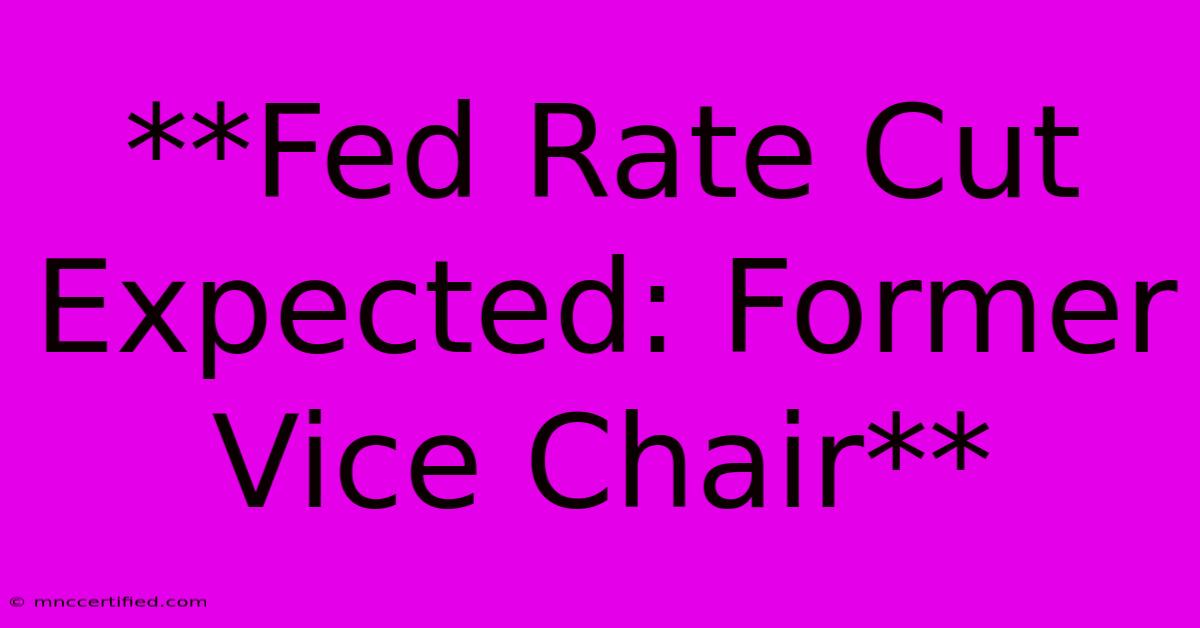**Fed Rate Cut Expected: Former Vice Chair**

Table of Contents
Fed Rate Cut Expected: Former Vice Chair Signals Shift in Monetary Policy
The Federal Reserve is facing increasing pressure to pivot from its aggressive interest rate hiking campaign, and recent comments from a prominent former official have fueled speculation about a potential rate cut in the near future. Richard Clarida, the former Vice Chair of the Federal Reserve, has publicly stated that he expects the Fed to lower interest rates later this year.
This statement comes as the U.S. economy grapples with a challenging landscape. While inflation has shown signs of cooling, it remains stubbornly elevated, and the specter of recession looms large. The labor market, while robust, is beginning to show signs of softening, with layoffs increasing across various sectors.
Clarida's Reasoning and Market Reactions
Clarida's prediction is based on his assessment of the current economic outlook. He believes that the Fed's aggressive rate hikes, aimed at curbing inflation, have already had a significant impact on economic activity. With inflation expected to continue cooling in the coming months, Clarida argues that the Fed will likely shift its focus to supporting growth and preventing a recession.
This statement has sent ripples through financial markets. Bond yields have declined, reflecting a decreased expectation of future interest rate hikes. The stock market has also reacted positively, with major indices rising on the news.
The Fed's Dilemma: Balancing Inflation and Growth
The Fed faces a difficult balancing act. While aggressively raising interest rates has helped curb inflation, it has also increased the risk of a recession. The central bank must carefully weigh the need to further cool inflation against the potential negative consequences for the economy.
Several factors will likely influence the Fed's decision on future interest rate moves, including:
- Inflation data: The Fed will closely monitor inflation data, particularly the Consumer Price Index (CPI) and the Personal Consumption Expenditures (PCE) price index, for signs of sustained cooling.
- Labor market conditions: The Fed will assess the labor market for signs of weakening, including job growth, unemployment rate, and wage growth.
- Economic growth: The Fed will analyze data on GDP growth and other economic indicators for signs of a potential recession.
The Impact of a Rate Cut
A Fed rate cut would likely have a mixed impact on the economy. It could help stimulate economic growth and boost consumer confidence, but it could also lead to renewed inflationary pressures.
For businesses: A rate cut could lower borrowing costs, making it easier to invest and expand. However, it could also make it more expensive to attract and retain talent.
For consumers: A rate cut could lower mortgage rates and make it more affordable to borrow money. However, it could also lead to higher prices for goods and services.
Looking Ahead
The future path of interest rates remains uncertain. While Clarida's comments suggest a potential shift in the Fed's monetary policy, it is too early to say when a rate cut might occur. The Fed will continue to carefully monitor economic data and adjust its policy stance accordingly.
Investors and businesses should remain vigilant and closely follow the Fed's communication and actions in the coming months.

Thank you for visiting our website wich cover about **Fed Rate Cut Expected: Former Vice Chair**. We hope the information provided has been useful to you. Feel free to contact us if you have any questions or need further assistance. See you next time and dont miss to bookmark.
Featured Posts
-
Does Insurance Cover Battery Replacement
Nov 08, 2024
-
Spiritual Therapist Covered By Insurance
Nov 08, 2024
-
Hawaii Captive Insurance Conference 2023
Nov 08, 2024
-
Insurance Agent Disclosure For Annuities
Nov 08, 2024
-
Health Insurance Agent In Summerville Sc
Nov 08, 2024